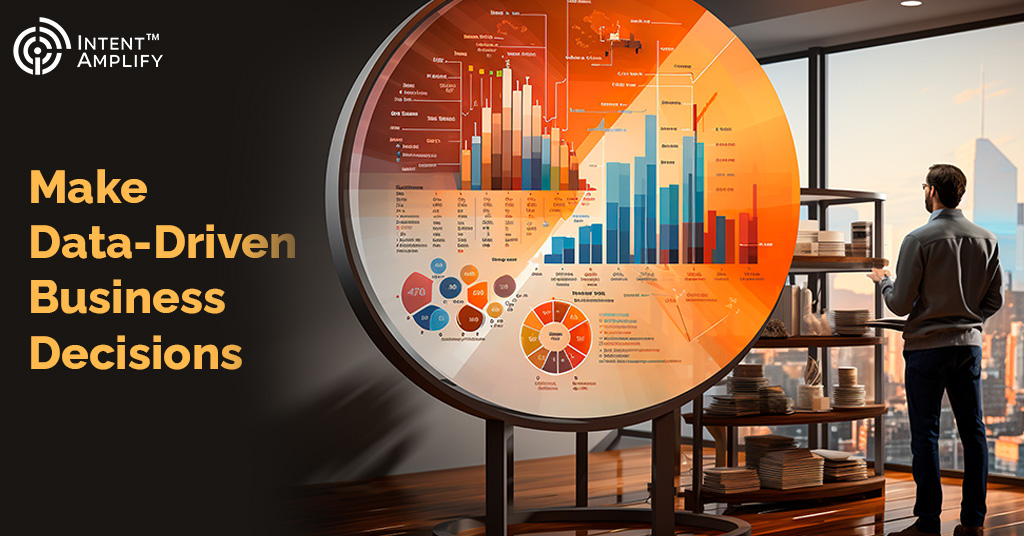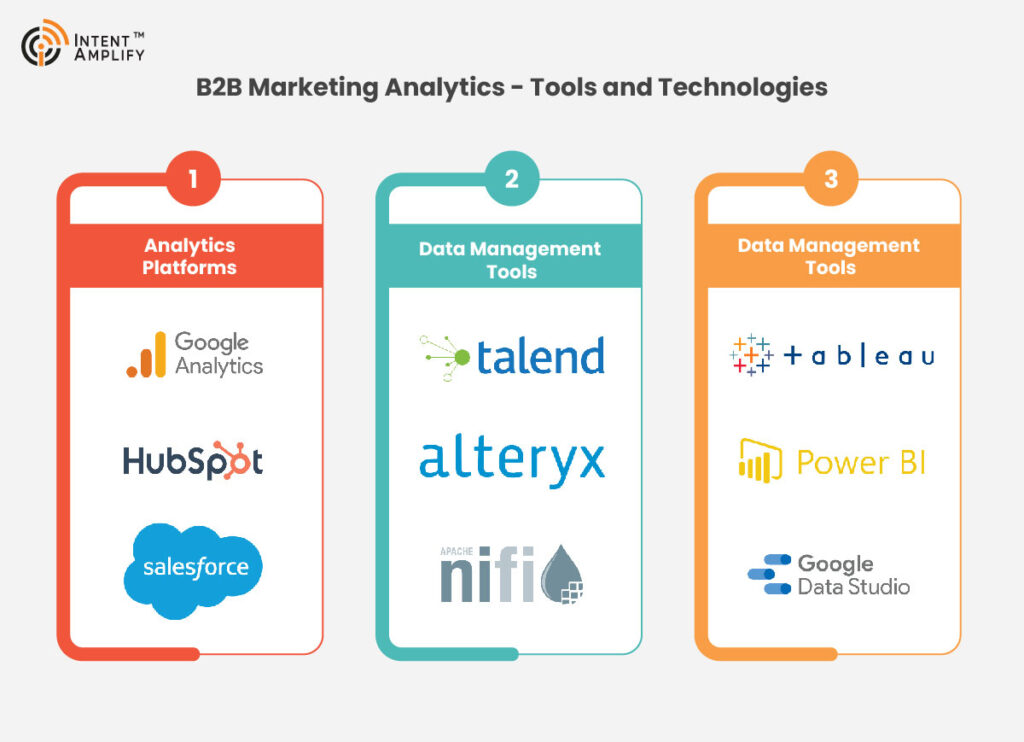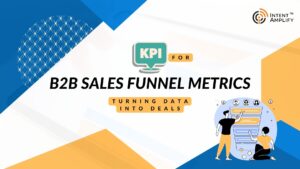
Leveraging B2B Marketing Analytics: Turning Data Chaos into Clarity
What is a successful B2B marketing campaign if not powered by data analytics?
Data is a powerful resource in itself. It gives excellent insights into your customer’s buying behaviors. It delivers the right information at the right time at each stage of the buyer’s journey, helping them to convert from prospects to customers to advocates. When this data is used for decision-making in marketing, it is often referred to as B2B marketing analytics.
More specifically, B2B marketing analytics refers to the process of collecting, analyzing, and interpreting data related to business-to-business (B2B) marketing activities. This involves using various analytical tools and techniques to gain insights into the effectiveness of marketing strategies, the behavior and preferences of business clients, and the overall performance of marketing campaigns. The goal is to make data-driven decisions that improve marketing outcomes and drive business growth.
Key Components of B2B Marketing Analytics
Understanding and utilizing B2B marketing analytics can significantly boost your business results. Here’s a closer look at its key components.
- Data Collection: To get a full picture of your marketing efforts, you need data from your CRM system, website analytics, social media platforms, email marketing tools, and sales data. You’ll be looking at numbers (quantitative data) like sales figures and conversion rates, but also at opinions and interactions (qualitative data) from customer feedback and social media.
- Data Integration: Bringing together data from all these sources gives you a holistic view of your marketing activities and their impact. It’s essential to ensure your data is clean and free from duplicates and errors, while also being formatted to maintain quality.
- Segmentation and Targeting: Breaking down your audience into smaller groups based on characteristics like industry, company size, location, and behavior makes it easier to manage and target them. Assigning scores to leads based on how likely they are to convert helps you prioritize your marketing and sales efforts on the most promising leads.
- Performance Measurement: Defining and tracking key performance indicators such as lead generation, conversion rates, customer acquisition cost, and lifetime value will tell you how well your marketing efforts are performing. Evaluate your marketing campaigns by looking at metrics like open rates, click-through rates, and return on investment (ROI).
- Predictive Analytics: Historical data can be used to predict future trends, like sales growth or potential customer churn. This helps in planning and strategy. Predictive analytics can anticipate customer actions based on past behavior and patterns, enabling you to engage them more effectively.
- Customer Journey Analysis: Mapping and analyzing customer interactions across different touchpoints, helps understand their journey better. Figuring out which marketing activities contribute most to conversions, helps you allocate your resources more effectively.
- Market and Competitive Analysis: Keeping an eye on market trends to stay ahead in your industry can lead to an informed strategy. Compare your performance against competitors to identify your strengths and weaknesses.
- Content and Channel Optimization: Measuring how different types of content resonate with various audience segments and adjusting accordingly. Analyze which marketing channels (like email, social media, or SEO) deliver the best results, so you know where to focus your efforts.
- Personalization: Use your data insights to create personalized marketing messages and offers for different segments or even individual clients. Develop customized marketing strategies for key accounts based on detailed data analysis, ensuring you meet their specific needs.
- Reporting and Visualization: Creating interactive dashboards that provide real-time insights into your marketing performance, makes it easier to monitor and adjust your strategies. Use charts, graphs, and other visualization tools to make data insights easy to understand and act upon.
By leveraging B2B marketing analytics, you can gain a deeper understanding of market dynamics, fine-tune your marketing strategies, improve customer targeting and engagement, and ultimately drive better business results.
B2B Marketing Analytics – Tools and Technologies
To make the most out of B2B marketing analytics, it’s essential to use the right tools and technologies. Here’s a rundown of some popular options that can help you collect, manage, and visualize your data effectively.

Analytics Platforms
Google Analytics:
- Widely used for tracking and analyzing web traffic
- Provides insights on popular pages, performance of marketing campaigns, visitor interaction
- It’s user-friendly and offers both basic and advanced features
HubSpot:
- Offers a comprehensive suite of marketing tools, including powerful analytics
- Allows tracking email open rates to social media interactions and sales conversions
- An integrated platform helps you manage and analyze data all in one place, making it easier to see the full picture.
Salesforce:
- Leading CRM platform that also offers robust analytics capabilities
- Track customer interactions, sales performance, and marketing campaign effectiveness
- Gain deep insights into customer behavior and business performance through its B2B marketing analytics tool
Data Management Tools
Talend:
- Data integration tool that helps you bring together data from various sources
- Great for cleaning and standardizing data, ensuring you have high-quality information to work with
- User-friendly interface makes it easy to connect different data sources and automate data workflows
Alteryx:
- Offers powerful data preparation and analytics capabilities
- Handles complex data tasks, from cleansing and integrating data to advanced analytics and machine learning
- Ease of use and ability to quickly process large datasets
Apache NiFi:
- Open-source tool for automating data flow between systems
- Excels at data ingestion, transformation, and routing, making it a valuable tool for managing large volumes of data
- NiFi’s visual interface allows you to design and monitor data flows easily
Visualization Software
Tableau:
- Turn data into interactive and shareable dashboards
- Intuitive drag-and-drop interface and ability to create stunning visualizations
- Makes it easy to explore data and uncover insights
Power BI:
- Allows you to connect to various data sources and create detailed reports and dashboards.
- Is particularly strong in integrating with other Microsoft products, making it a popular choice for businesses already using the Microsoft ecosystem.
Google Data Studio:
- Free tool that lets you create customizable reports and dashboards
- Integrates seamlessly with other Google products like Google Analytics and Google Sheets
Using these tools, you can efficiently collect, manage, and visualize your marketing data, helping you make informed decisions and drive business growth.
Best Practices for Implementing B2B Marketing Analytics
Implementing B2B marketing analytics effectively can transform your marketing efforts and drive significant business growth. Here are some best practices to help you get the most out of your analytics initiatives.
- Maintaining Data Quality
- Ensure Accurate Data Collection: Establish clear guidelines for data entry to minimize errors and inconsistencies. This includes using standardized formats for dates, names, and other key fields. Where possible, automate the collection process to reduce human error. Use tools like CRM systems and marketing automation platforms to capture data consistently.
- Regular Data Cleaning: Regularly audit your data to identify and remove duplicate entries. Duplicates can skew your analytics and lead to inaccurate insights. Implement processes for identifying and correcting data errors, such as incorrect contact information or outdated records. Keep your data current by scheduling regular updates. Outdated data can lead to poor decision-making.
- Ensuring Data Privacy
- Compliance with Regulations: Stay informed about data privacy regulations like GDPR, CCPA, and others that apply to your business. Ensure your data practices comply with these laws to avoid penalties. Always obtain explicit consent from individuals before collecting their data. Clearly explain how their data will be used and stored.
- Implement Security Measures: Use encryption to protect data both in transit and at rest. This helps prevent unauthorized access and data breaches. Limit access to sensitive data to only those employees who need it to perform their job functions. Use role-based access controls to enforce this. Conduct regular security audits to identify and address potential vulnerabilities in your data management processes.
- Continuously Improving Analytics Processes
- Adopt an Iterative Approach: Begin with a few key metrics and gradually expand your analytics efforts as you gain more experience and confidence. Schedule regular reviews of your analytics processes to identify areas for improvement. Use feedback from these reviews to refine and enhance your strategies.
- Invest in Training: Ensure your team has the necessary skills to effectively use analytics tools and interpret data. Offer regular training sessions and provide access to online courses and resources. Encourage a culture of data-driven decision-making within your organization. Highlight the value of analytics in driving business outcomes and recognize employees who use data effectively.
- Leverage Advanced Analytics: Use predictive analytics to anticipate future trends and behaviors. This can help you stay ahead of the competition and make proactive business decisions. Integrate machine learning techniques to analyze complex data sets and uncover deeper insights. This can enhance your ability to personalize marketing efforts and improve targeting.
- Collaborate Across Departments:
- Work with other departments, such as sales and customer service, to develop a unified data strategy. This ensures that everyone is working with the same data and pursuing common goals. Regularly share analytics insights with relevant stakeholders. This helps ensure that data-driven decisions are made at all levels of the organization.
- By following these best practices, you can effectively implement B2B marketing analytics, maintain high data quality, ensure data privacy, and continuously improve your analytics processes. This will enable you to make informed decisions, optimize your marketing strategies, and drive better business results.
Conclusion
The ultimate goal of B2B marketing analytics is to help businesses make data-driven decisions about their marketing investments. By understanding what’s working and what’s not, businesses can allocate their resources more effectively and achieve their marketing goals.




